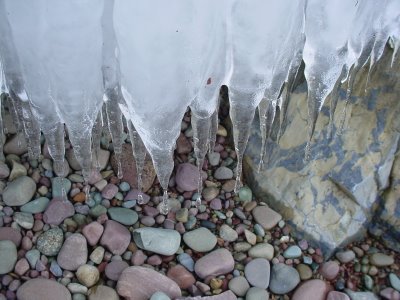 This is the image from my sister's front window - a panorama of ice and snow, icicles and the long hibernation of winter. It is a comfort to be inside, looking outward, knowing that one is safe and warm.
This is the image from my sister's front window - a panorama of ice and snow, icicles and the long hibernation of winter. It is a comfort to be inside, looking outward, knowing that one is safe and warm.Outside, the long icicles had reached dangerous lengths, and after filming them, my brother-in-law, Frank, took a straight-edged shovel and knocked all of them down so they wouldn't shatter into the window.
As the week progressed, the snow on the roof began to slide down over the eaves, and the house had a mushroom appearance, with huge drifts covering the roof. The force of gravity had pulled the snow down. When it melts, the icicles will drip until a chinook comes, which will thaw everything. Eventually the precipitation of winter will drip, plop, and thud, down into the grass and bushes surrounding the house.
 Moisture covered everything, with little touches of frost. This is a windowpane holding the moisture in the garage, with just a few scant inches free of moisture.
Moisture covered everything, with little touches of frost. This is a windowpane holding the moisture in the garage, with just a few scant inches free of moisture. We took a drive into the country on the last day I was in the Flathead Valley, and walked around Lake McDonald in Glacier Park. The roads were plowed, and we walked along the lakeshore.
The huge boulders at the entrance to McDonald Creek were topped with snow and laden with heavy icicles that dripped during the middle of the day.
 Little drops of water cascaded down the sides of boulders and dropped into the water. They would mix with other drops and find pathways into the creek which meandered snowbound under sheets of ice.
Little drops of water cascaded down the sides of boulders and dropped into the water. They would mix with other drops and find pathways into the creek which meandered snowbound under sheets of ice.One day, when we ventured into town, Bonnie, Mel, and I had breakfast with a 73 year old geologist who had done research on volcanic deposits and seismic testing. After this woman got her doctorate, she studied rock formations around an indentation in the ground caused by a meteor. As the ground rippled outwardly, there were bands of different rocks and metals, each distinguished by an upheavel of earth and gravel. Some of these berms were only inches tall, in concentric circles around the impact area.
 It was the geologist's job to carry a gravity-meter, an $18,000 dollar piece of equipment that is used to measure the gravitational pull of the sun and moon on the surface of the earth. She would have to walk very carefully, so as to keep the internal components of the meter in perfect allignment. She also had to position it very carefully, then position herself precariously over the instrument to take the readings. Fractions of inches of the earth's surface were pulled during the 'tides' bearing on the earth. These fractions were recorded, and used as part of her study.
It was the geologist's job to carry a gravity-meter, an $18,000 dollar piece of equipment that is used to measure the gravitational pull of the sun and moon on the surface of the earth. She would have to walk very carefully, so as to keep the internal components of the meter in perfect allignment. She also had to position it very carefully, then position herself precariously over the instrument to take the readings. Fractions of inches of the earth's surface were pulled during the 'tides' bearing on the earth. These fractions were recorded, and used as part of her study. I recently read that each day as many as 4 billion meteors, most miniscule in size, fall to earth. Their masses total several tons, seemingly a large amount, but negligible compared to the earth's total mass of 6,600,000,000,000,000,000,000 tons.
I recently read that each day as many as 4 billion meteors, most miniscule in size, fall to earth. Their masses total several tons, seemingly a large amount, but negligible compared to the earth's total mass of 6,600,000,000,000,000,000,000 tons. It was this geologist's job to measure the rocks strewn by a meteor upon impact.....I think of her now, playing her violin, with her life's work primarily behind her. Had someone walked through the forest, seeing her bent over this space-age looking device, they could have thought she had a few screws loose.
I'd enjoy hearing the dialogue as they came tromping nearby, disturbing the sensitive vibrations she was trying to calculate.